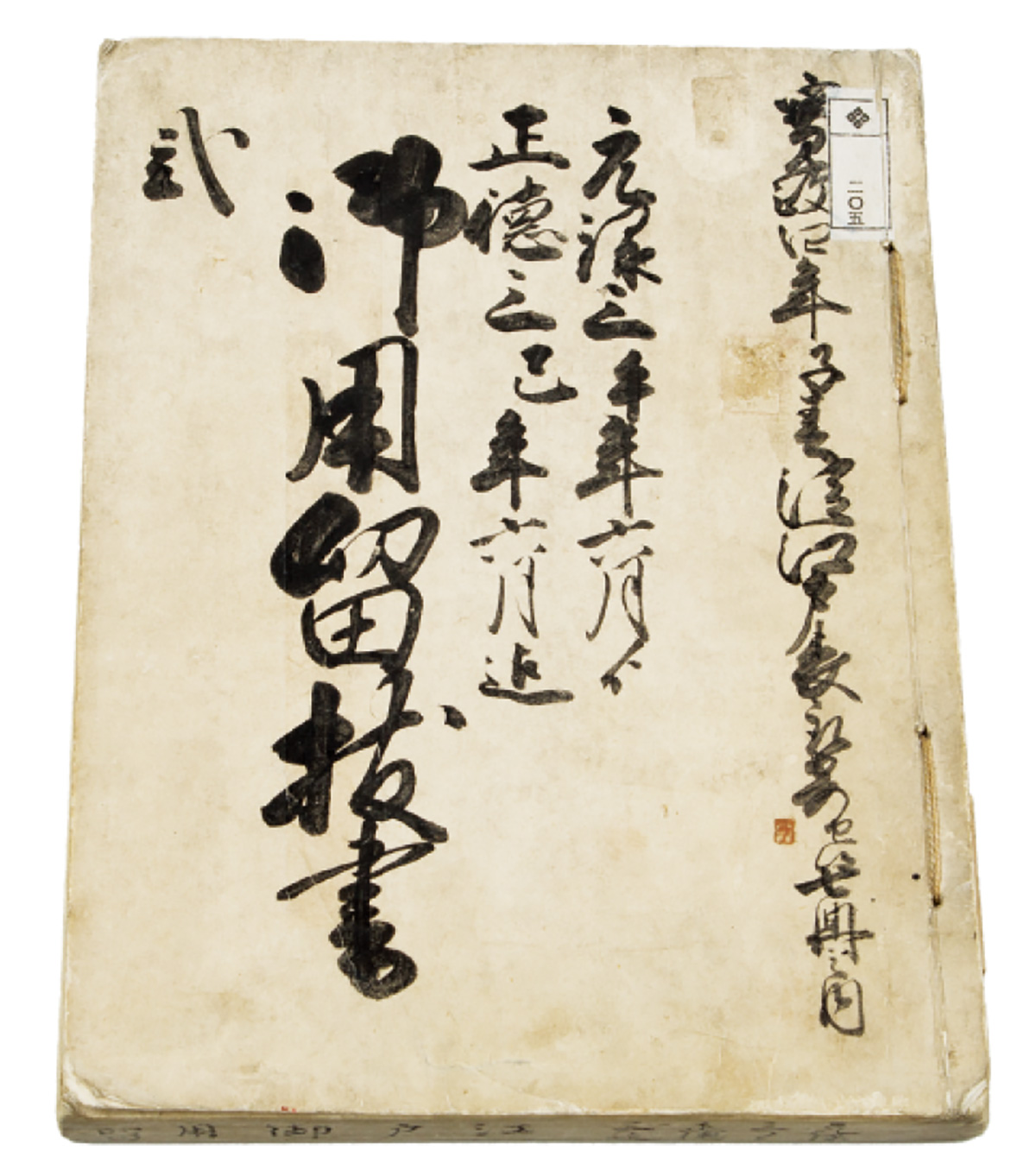05 Chartered Purveyor to the Shogunate
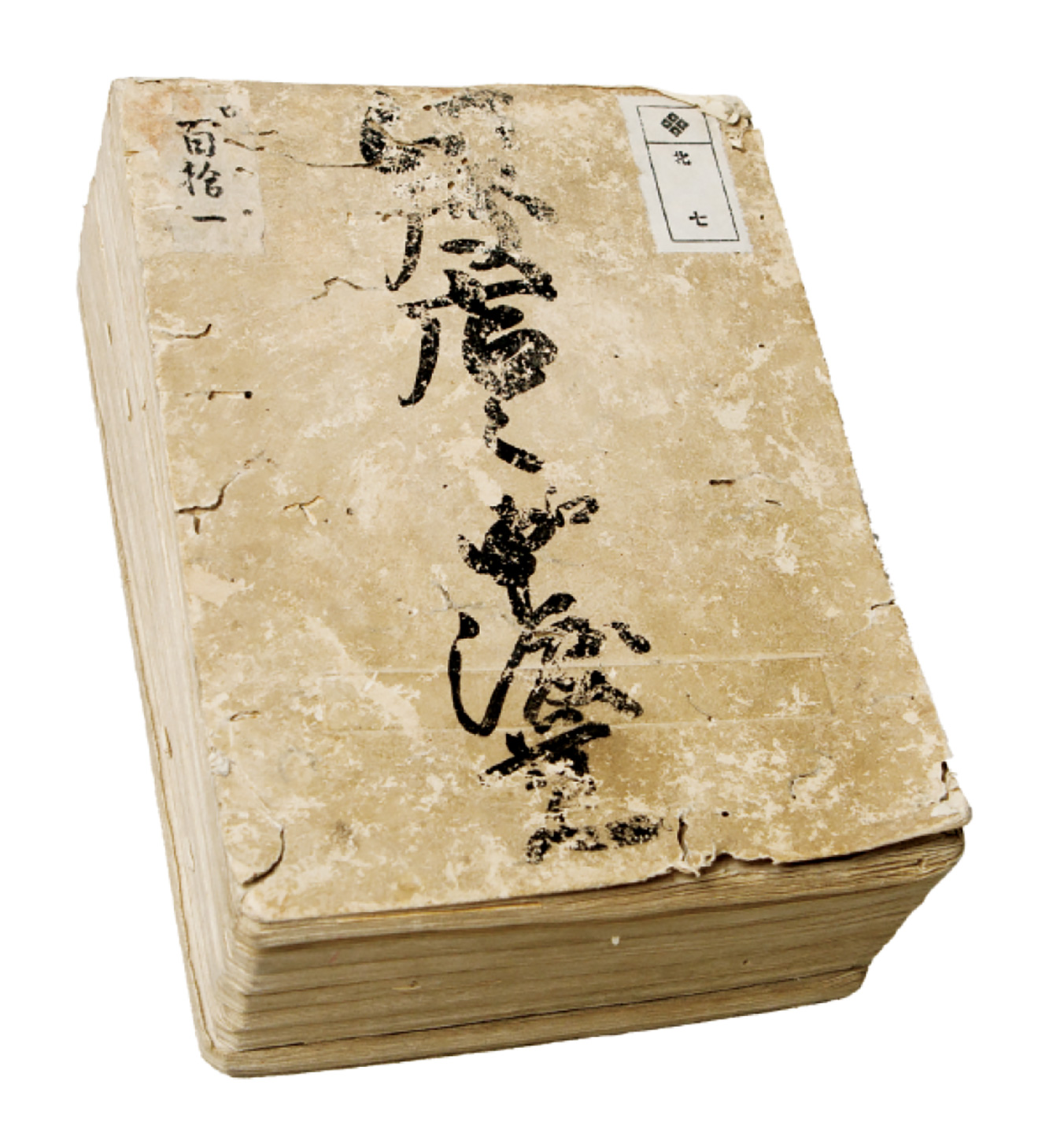
Purveyor to the Shogunate (Kimono)
In 1687, under the name of Takatoshi’s eldest son Takahira (→06), the Mitsuis became official merchant purveyors to the shogunate. The document shown below (→Fig. 05a) is a copy of a letter submitted to the shogunate after the charter to be a purveyor had been handed down from Takahira to the next generation in 1701. It records the history of how the charter was accepted.
At first, the charter accepted was for handling clothing for the shogun to gift to his vassals, and soon thereafter their charter also involved handling clothing for the shogun. The intermediator was Makino Narisada, a favored retainer of the 5th shogun Tsunayoshi. It is said that go-fancier Makino heard about Mitsui from Honinbo Doetsu (a noted go player), who hailed from the same domain as Takatoshi.
According to Shobaiki (→04), the harassment of Mitsui escalated even after he relocated to Surugacho. There were frequent lawsuits, for example, and anonymous letters denouncing him circulated the neighborhood, saying such things as, “Let’s hire a masterless samurai to set fire to the house at night and completely wipe out him and his employees.” However, the text says, this stopped when Mitsui became an official purveyor merchant. Mitsui felt deeply indebted to the Makino family, and the Mitsuis treated them with special care throughout the early modern period even after Narisada passed away (→18).
Purveyor to the Shogunate (Money Exchange)
Furthermore, in 1690, under the names of Takahira and his younger brother Takatomo (→06), the Mitsuis accepted an official charter to purvey an accounting office that administered the shogunate’s finances. Such charters had merchants such as the Mitsuis receive the official deposits of the shogunate in Osaka, organize an exchange, and pay it out to the authorities in Edo by the appointed date (→16). The shogunate had been converting the annual rice tributes that were an important revenue source into gold and silver in Osaka, and then transporting that by horse to Edo. They would reduce the work involved by getting the exchange.
Some years before, Mitsui had asked the Kofu Tokugawa family for a very similar charter. When it came obtaining the charter to be an official purveyor to the shogunate, it seems that Ogiwara Shigehide-a powerful figure in the shogunate’s accounting office-was influential.
Thanks to this, the Mitsuis were constantly able to receive enormous amounts of capital from the shogunate and put it to work.
Development of a Financial Division
Mitsui had also already established a money exchange store at the time of its move to Surugacho (→03). While at first it played an auxiliary role to the kimono fabric business, with the acceptance of the money exchange charter from the shogunate the financial division that had been making loans and exchanging money developed further. In response, the shops that previously had been part of the kimono fabric division in 1705 were grouped into the “Hondana ichimaki” kimono shop chain (→12), and those that were part of the financial division were finally grouped to the “Ryogaedana ichimaki” exchange houses chain (→16). These formed the two halves of the whole for the business in the early modern period (→10).
Expanding the Shop Network
With acceptance of the charter and the development of the Mitsui business, the expansion of existing shops and opening of new ones also continued. When the move to Surugacho was made, Mitsui had both a kimono fabric shop and money exchange store on the south side of the street (where Mitsukoshi is today). However, it soon became cramped, and the money exchange store was moved to the north side (the present site of the Mitsui Main Building). Next to it they located a cotton shop (later Mukodana) that handled garments of silk, cotton, and the like for the general public. In 1698, the cotton shop and kimono fabric shop traded locations, and the Surugacho landscape that would become a noted place of interest in Edo was created (→03).
In Kyoto, Mitsui greatly expanded the procurements shop and, in 1685 opened its Kaminotana shop to pay financing in advance to textile manufacturers in the city’s Nishijin district to be able to directly and systematically lay in stock of fabrics. The following year, Mitsui set up a money exchange store in the Shinmachi district, and Takatoshi lived in the back. In 1696, they set up a thread shop to handle thread and silk.
In Osaka, Mitsui opened a shop for selling kimono fabric in 1691 in Koraibashi 1-chome. With it they also opened a money exchange store to handle the money exchange purveyor’s charter.
Back in Matsusaka where Mitsui’s business began, they had their Matsusaka shop for laying in stocks of cotton from around Ise.
In this way, Mitsui built up a solid status as a major merchant with many shops in Edo, Kyoto, and Osaka, and who also had a close relationship with the shogunate.

A thick set of rules for the shops in Edo, drafted by Takatoshi’s second son Takatomi (→06). They have been handed in the Kita family, the Mitsui head branch.
It is surmised that they were drafted in 1706. Takatomi at the time was in the position of controlling the business. This historical document was prepared for succeeding generations, and stipulated how business was to be handled at each shop. The content is extremely detailed, going so far as to minutely stipulate the duties of top managers, the grades of products, and the handling documents.
While Takatoshi’s sons wrote a variety of documents about what his life was like, they left behind very few about the years of growth after his passing when the sons themselves were at the center stage, making this an extremely valuable record.
Detailed rules for shops in Edo
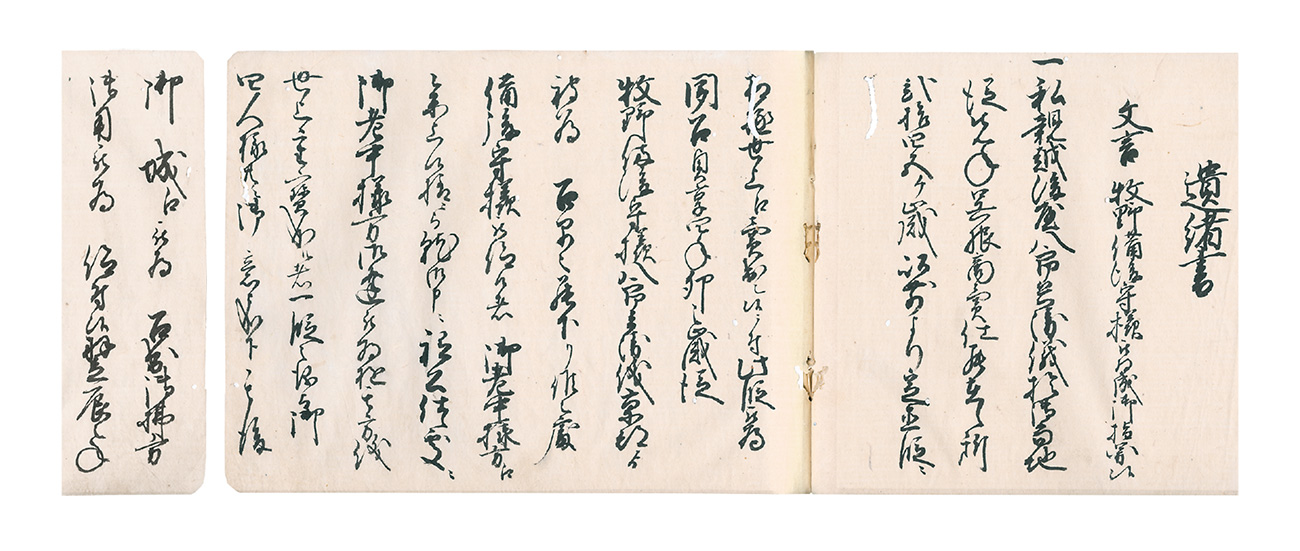
Translation
Historical record
(Note) The wording was directed by Makino Narisada. Takahira, my (Takahisa’s) parent, has been selling kimono fabrics in Edo for some time now. Starting 24 or 25 years ago, he has been selling them to the public at a fixed price. Hearing of this, in 1687 Mr. Makino summoned Takahira from Kyoto. Takahira quickly went to Edo. When he arrived, Mr. Makino told him to go pay his respects to the [shogun’s] senior councilors. When he made the visit, he was met by four senior councilors. The four said to him that “you will do as someone useful to the world.” He was then invited to Edo Castle, and there he was chartered to purvey clothing for the shogun to gift to his vassals.
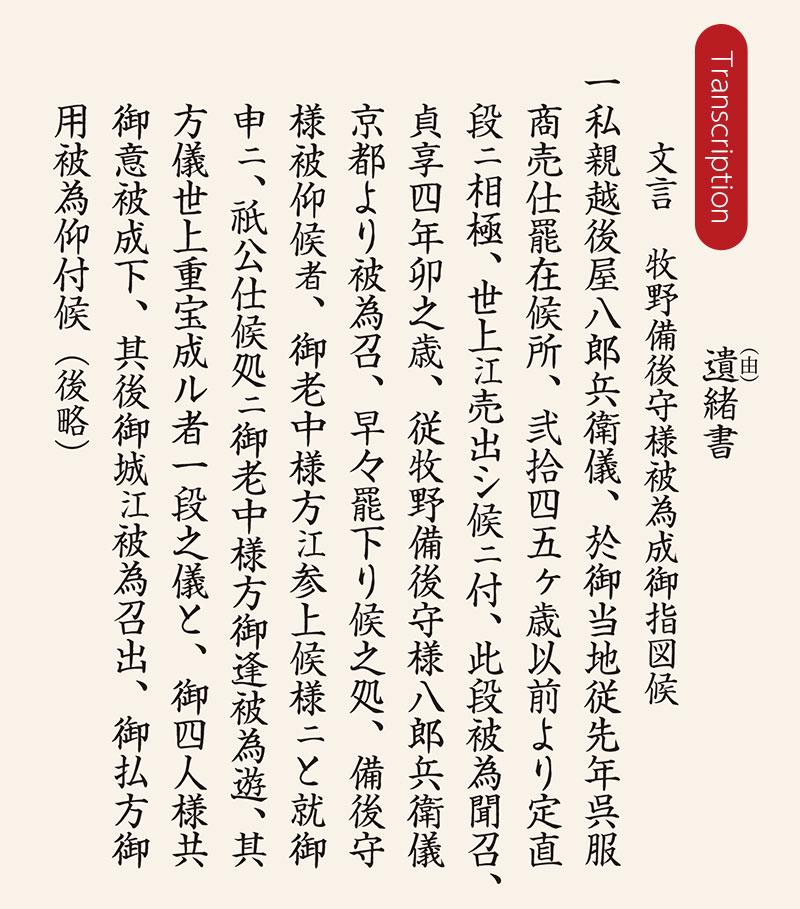
Translation
Historical record
(Note) The wording was directed by Makino Narisada. Takahira, my (Takahisa’s) parent, has been selling kimono fabrics in Edo for some time now. Starting 24 or 25 years ago, he has been selling them to the public at a fixed price. Hearing of this, in 1687 Mr. Makino summoned Takahira from Kyoto. Takahira quickly went to Edo. When he arrived, Mr. Makino told him to go pay his respects to the [shogun’s] senior councilors. When he made the visit, he was met by four senior councilors. The four said to him that “you will do as someone useful to the world.” He was then invited to Edo Castle, and there he was chartered to purvey clothing for the shogun to gift to his vassals.
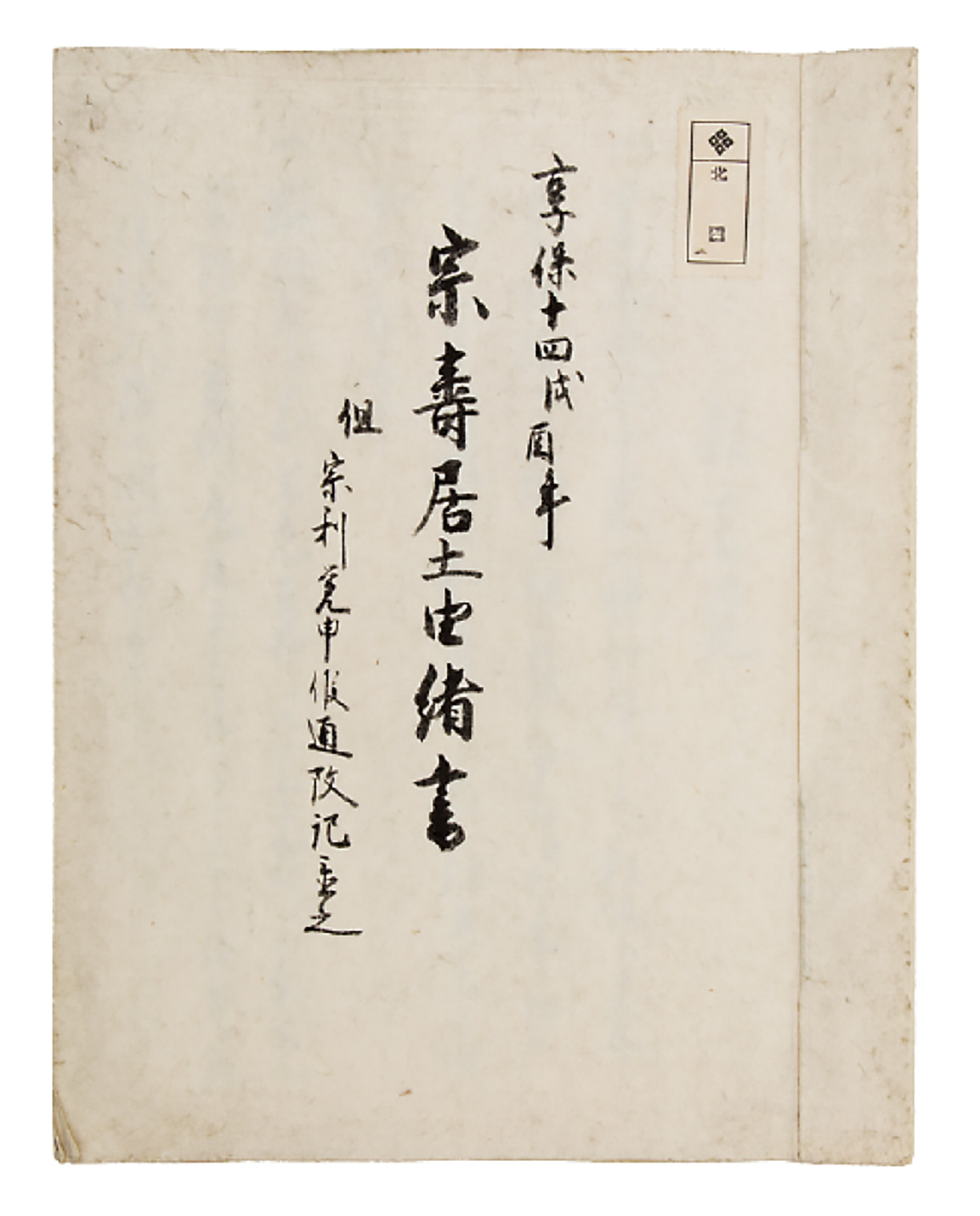
Written in 1729 by Takatoshi’s fourth son Takatomo (→06) in his twilight years. Provides a detailed history of the acceptance as a purveyor.


